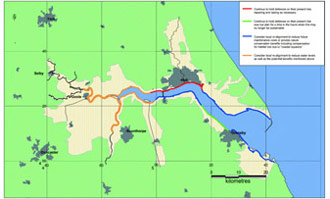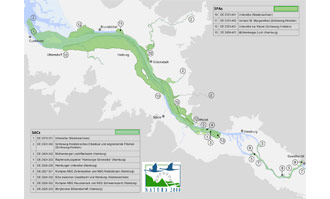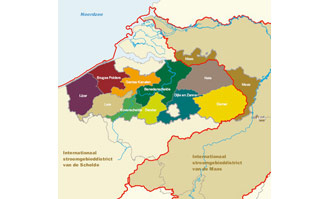

Disclaimer:
The authors are solely responsible for the content of this report. Material included herein does not represent the opinion of the European Community, and the European Community is not responsible for any use that might be made of it.
Back to overview reports
Council Directive 92/43/EEC of 21 May 1992 on the conservation of natural habitats and of wild fauna and flora is the means by which the EU meets its obligations under the Bern Convention. The Directive was amended in 1997 by a technical adaptation directive with further amendments of the annexes by the Environment Chapter of the Treaty of Accession 2003 and in 2007 when Bulgaria and Romania joined the EU. The Habitats Directive obliges Member States to promote the maintenance of biodiversity by requiring measures to maintain or restore natural habitats and wild species listed on the Annexes to the Directive at a favourable conservation status and introducing robust protection for those habitats and species of European importance. In applying these measures, Member States are required to take account of economic, social and cultural requirements, as well as regional and local characteristics. The Directive protects over 1000 animals and plant species and over 200 "habitat types" (e.g. special types of forests, meadows, wetlands, etc.) which are of European importance.
In the words of the European Commission, the Habitats Directive, together with the Birds Directive, constitutes the ‘cornerstone of the EU’s conservation policy’.
These directives have been transposed into national and federal law within the four TIDE countries through:
¹ The Belgian situation is particularly complex since most competences relating to biodiversity and territorial issues are dependent on the three different regions (Brussels Capital Region, Flanders and Wallonia). This means that Belgium generally has three sets of legislation for a given thematic area, or more when some competences still remain at federal level.
The operational implementation of the Wild Birds and Habitats Directives within each of the four TIDE estuaries is shown (see Appendix 1a-e) on four schematic frameworks detailing how the directives have been implemented from a top-down basis.
All EU governments have provided considerable guidance to their national conservation bodies on how to apply the requirements of the Habitats and Birds Directives at the national level. At an estuary level, competent authorities have combined to establish management schemes to ensure that the European Marine Sites (EMS) are protected from potentially damaging activities. Any competent authority can establish a management scheme as this is an optional requirement of the European directive and national legislation and not mandatory. In order to achieve this, steering groups have been adopted within each of the estuaries included in the TIDE project.
At an estuary level, the management scheme for the Humber Estuary has been produced by a partnership of over 30 Relevant Authorities that have jurisdiction on or around the Humber Estuary. They are all equal members of the Humber Estuary Relevant Authorities Group (HERAG) that has developed the scheme and are now tasked with implementing it with the ongoing advice and support of the Humber Advisory Group. The HERAG collectively funds the Humber Management Scheme and employs a Project Officer to coordinate the implementation of the scheme on a day to day basis. All Humber Management Scheme business is discussed and agreed by involving all the members.
² The Belgian situation is particularly complex since most competences relating to biodiversity and territorial issues are dependent on the three different regions (Brussels Capital Region, Flanders and Wallonia). This means that Belgium generally has three sets of legislation for a given thematic area, or more when some competences still remain at federal level.
At an estuary level, a single steering committee has been formed to oversee the management and implementation of the Integrated Management Plans (Natura 2000) of the three German estuaries of the Weser andElbe (FFH-Lenkungsgruppe consisting of the Environmental and Economic State Ministries of the relevant 4 Federal States Bremen, Hamburg, Lower Saxony and Schleswig-Holstein, the Waterways administration and Hamburg Port Authority). Under this umbrella group, each estuary has a working group (comprised of relevant authorities) and planning/advisory groups (comprised of voluntary organisations and stakeholder groups).
Back to top
What tool is available to help manage multiple users of a resource in an integrated way (i.e. achieving more holistic management)?
Legislative Drivers & Sectoral Plan Review of TIDE Estuaries
Table of content
- 1. Introduction
- 1a. Overview
- 1b. Methodology
- 2. Management Drivers
- 2a. Birds Directive (2009/147/EC) & Habitats Directive (92/43/EEC)
- 2b. Water Framework Directive (2000/60/EC)
- 2c. Marine Strategy Framework Directive (2008/56/EC)
- 2d. Flood Risk Management Directive (2007/60/EC)
- 3. Key Players and Management Structures
- 3a. Humber Estuary
- 3b. Elbe Estuary
- 3c. Weser Estuary
- 3d. Scheldt Estuary
- 4. Management Plans & SWOT Analysis
- 4a. Management Plans
- 4b. SWOT Analysis
- 4c. SWOT Tables
- 5. Conclusions
- 5a. Environmental Drivers
- 5b. Best Practice
- 5c. SWOT
Authors:
By: Boyes, S., Cutts, N.D. & Elliott, M.
Supported by: Wild-Metzko S., Knüppel J., Saathoff S., Hürter D., Kress J., Roose F., Geerts L.
By: Boyes, S., Cutts, N.D. & Elliott, M.
Supported by: Wild-Metzko S., Knüppel J., Saathoff S., Hürter D., Kress J., Roose F., Geerts L.
2a. Birds Directive (2009/147/EC) & Habitats Directive (92/43/EEC)
Directive 2009/147/EC of the European Parliament and of the Council of 30 November 2009 on the conservation of wild birds (this is the codified version of Directive 79/409/EEC as amended) is the EU’s oldest piece of nature legislation and one of the most important, creating a comprehensive scheme of protection for all wild bird species naturally occurring in the Union. It was adopted unanimously by the Members States in 1979 as a response to increasing concern about the decline in Europe's wild bird populations resulting from pollution, loss of habitats as well as unsustainable use. It was also in recognition that wild birds, many of which are migratory, are a shared heritage of the Member States and that their effective conservation required international co-operation . The Birds Directive also meets the EU obligations for bird species under the Bern Convention and the Bonn Convention.Council Directive 92/43/EEC of 21 May 1992 on the conservation of natural habitats and of wild fauna and flora is the means by which the EU meets its obligations under the Bern Convention. The Directive was amended in 1997 by a technical adaptation directive with further amendments of the annexes by the Environment Chapter of the Treaty of Accession 2003 and in 2007 when Bulgaria and Romania joined the EU. The Habitats Directive obliges Member States to promote the maintenance of biodiversity by requiring measures to maintain or restore natural habitats and wild species listed on the Annexes to the Directive at a favourable conservation status and introducing robust protection for those habitats and species of European importance. In applying these measures, Member States are required to take account of economic, social and cultural requirements, as well as regional and local characteristics. The Directive protects over 1000 animals and plant species and over 200 "habitat types" (e.g. special types of forests, meadows, wetlands, etc.) which are of European importance.
In the words of the European Commission, the Habitats Directive, together with the Birds Directive, constitutes the ‘cornerstone of the EU’s conservation policy’.
Humber Estuary Management Plans
Elbe Estuary Management Plans
Weser Estuary Management Plans
Scheldt Estuary Management Plans
These directives have been transposed into national and federal law within the four TIDE countries through:
| TIDE Estuary | National/Federal Implementation |
| Humber (England) | Conservation of Habitats and Species Regulations 2010 (as amended) Wildlife and Countryside Act 1981 (as amended). |
| Elbe & Weser (Germany) | National level: Federal Nature Conservation Act (BNatSchG 2010); Federal state level: The conservation acts of the Federal states Bremen (BremNatG 2010), Lower Saxony (NAGBNatSchG 2010) and Schleswig-Holstein (LNatSchG 2010), Hamburg (HmbNatSchG 2010) |
| Scheldt (The Netherlands) | Nature Conservation Act and the Flora and Fauna Act. |
| Scheldt (Belgium)¹ | Law on Nature Conservation 1973. It has been adapted to the regional context by the Nature Protection Order of 1995 in the Brussels Capital Region, the Nature Decree of 1997 (modified in 2002) in Flanders and the Natura 2000 Decree of 2001 in Wallonia. |
¹ The Belgian situation is particularly complex since most competences relating to biodiversity and territorial issues are dependent on the three different regions (Brussels Capital Region, Flanders and Wallonia). This means that Belgium generally has three sets of legislation for a given thematic area, or more when some competences still remain at federal level.
The operational implementation of the Wild Birds and Habitats Directives within each of the four TIDE estuaries is shown (see Appendix 1a-e) on four schematic frameworks detailing how the directives have been implemented from a top-down basis.
All EU governments have provided considerable guidance to their national conservation bodies on how to apply the requirements of the Habitats and Birds Directives at the national level. At an estuary level, competent authorities have combined to establish management schemes to ensure that the European Marine Sites (EMS) are protected from potentially damaging activities. Any competent authority can establish a management scheme as this is an optional requirement of the European directive and national legislation and not mandatory. In order to achieve this, steering groups have been adopted within each of the estuaries included in the TIDE project.
UK - Humber
In the UK this has been carried out in the form of national guidance provided by Defra and JNCC. National Planning Policy Framework (NPPF) adopted in April 2012 under the Localism Act 2011 and Government circulars² also provide guidance for local authorities in their planning consents, however they have no statutory status, and are for guidance only. Even with the new UK Conservation Regulations 2010, no substantive changes were required to previous guidance provided in 2005 as there were no significant changes to any policies or procedures.At an estuary level, the management scheme for the Humber Estuary has been produced by a partnership of over 30 Relevant Authorities that have jurisdiction on or around the Humber Estuary. They are all equal members of the Humber Estuary Relevant Authorities Group (HERAG) that has developed the scheme and are now tasked with implementing it with the ongoing advice and support of the Humber Advisory Group. The HERAG collectively funds the Humber Management Scheme and employs a Project Officer to coordinate the implementation of the scheme on a day to day basis. All Humber Management Scheme business is discussed and agreed by involving all the members.
² The Belgian situation is particularly complex since most competences relating to biodiversity and territorial issues are dependent on the three different regions (Brussels Capital Region, Flanders and Wallonia). This means that Belgium generally has three sets of legislation for a given thematic area, or more when some competences still remain at federal level.
Germany – Elbe & Weser
In Germany, national monitoring and assessment schemes have been provided to relevant authorities for the implementation of the Habitats and Birds Directives. As the management of the Elbe and Weser is mainly set up at a Federal State level, each estuary has an Integrated Management Plan. If national guidance is required, e.g. inter-estuarine priorities for conservation status improvement, the existing National Working Group on Natura 2000 or the steering committee for the North Sea estuaries (see appendix 1b&c) shall fill the gap.At an estuary level, a single steering committee has been formed to oversee the management and implementation of the Integrated Management Plans (Natura 2000) of the three German estuaries of the Weser andElbe (FFH-Lenkungsgruppe consisting of the Environmental and Economic State Ministries of the relevant 4 Federal States Bremen, Hamburg, Lower Saxony and Schleswig-Holstein, the Waterways administration and Hamburg Port Authority). Under this umbrella group, each estuary has a working group (comprised of relevant authorities) and planning/advisory groups (comprised of voluntary organisations and stakeholder groups).
The Netherlands & Flanders - Scheldt
In the Netherlands official statutes indicate conservation objectives set for the protection of the WesterScheldt and Saeftinghe. A Natura 2000 management plan has been developed in the Netherlands, as required by the Dutch Nature Protection Act (1998). In the Flemish part of the Scheldt estuary, conservation of SACs and SPAs is assured by ‘het Natuurdecreet Vlaanderen’ since 1998. After development of ‘het Natuurontwikkelingsplan Scheldt-estuarium’ (2003), ‘Langetermijnvisie Scheldt-estuarium 2030’ and ‘Ontwikkelingsschets 2010’, the conservation objectives for Natura 2000 were decided by the Flemish Government and translated into several projects in the Revised Sigmaplan (2005), which aims to protect inhabitants within the Scheldt estuary for floods, assure the accessibility for ports and at the same time ensure the conservations objectives for Natura 2000. Three SPAs, four SACs and one Ramsar area fall within the Flemish part of the Scheldt estuary.Important to know
Reports / Measures / Tools
| Report: | Management measures analysis and comparison |
|---|
Management issues
What are the relative strengths and weaknesses of different TIDE management plans and actions?What tool is available to help manage multiple users of a resource in an integrated way (i.e. achieving more holistic management)?















